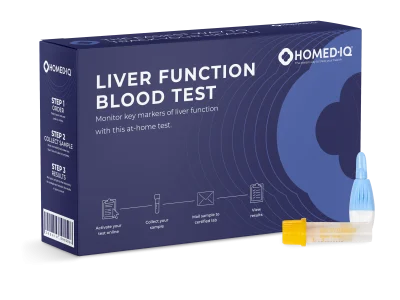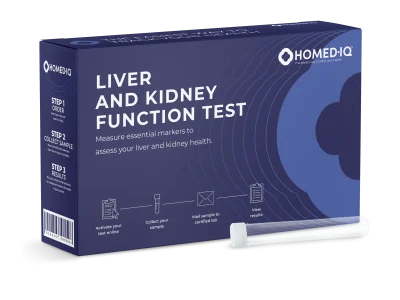Alanine aminotransferase (ALT) is an enzyme found primarily in liver cells, and to a lesser extent in other cells of the body. When the liver is damaged or inflamed, excess ALT can leak into the bloodstream. Therefore, testing ALT can give you insight into the functioning of your liver. Homed-IQ offers a home test for ALT and other key liver enzymes to test the health of your liver. In addition to ALT, this test also analyzes other values, such as AST, Gamma GT, Alkaline Phosphatase, and bilirubin.
What is ALT?
ALT is a liver enzyme. As a protein, ALT ensures that certain substances are converted into other substances. When the liver is damaged or inflamed, ALT can leak out of the liver and end up in the blood. Even minor damage to the liver can cause slightly elevated ALT levels. The liver has many important functions, including removing toxic substances from the blood. The liver also ensures absorption of vitamin D and vitamin K, as fat-soluble vitamins.
What are normal ALT values?
To determine whether you have a healthy ALT level, it is important to know what the reference values are. According to the standard of NHG (Nederlands Huisartsen Genootschap) a different reference value applies for men and women:
ALT value for men: < 45 U/L
ALT value for women: < 34 U/L
When is ALT too high?
The ALT (alanine aminotransferase) level in the blood should normally be between 10-55 U/L (units per litre) for males and between 7-45 U/L (units per litre) for females. Values above this may indicate liver disease or damage; see the table for severity levels and interpretations. A rule of thumb for ALT is that it should not be more than three times the upper limit of normal to be considered healthy.
| ALT Category/ Reference Range | ALT value (U/L) Men | ALT value (U/L) Women | Interpretation/ Health condition |
| Normal Values | 10–55 U/L | 7–45 U/L | Normal liver function |
| Elevated Values | > 55 U/L | > 45 U/L | Indication of liver problems, such as liver inflammation or damage |
| Moderate Elevation | 100–400 U/L | 100–400 U/L | Liver damage, but often treatable with minimal long-term effects |
| Severe Elevation | 400–1,000 U/L | 400–1,000 U/L | Significant liver damage; liver cells begin to die |
| Very High Values | > 2,000 U/L | > 2,000 U/L | Acute liver damage; immediate medical intervention required |
ALT Testing
If you want to know what the performance of your liver is, it is possible to test the value of ALT. This gives an objective picture of your liver’s function and can be important to uncovering a liver condition because symptoms are not always present in liver disease. Homed-IQ has a home test available that allows users to determine their ALT value, along with several other key liver enzymes. The test involves taking a blood sample using a finger prick. This sample is then analyzed by a certified laboratory. Homed-IQ’s Liver Function Blood Test also evaluates the following biomarkers:
With the Liver and Kidney Function Test, you can also analyses important markers for your kidney health.
-

Liver Function Blood Test
€45,00 -

Liver and Kidney Function Test
€55,00
What is the difference between ALT and AST?
ALT and AST are both liver enzymes, but they are different from each other in several ways. The production of ALT takes place in the main type of liver cells (hepatocytes). The level of ALT in the blood rises when these liver cells are damaged or have died.
AST (Aspartate Aminotransferase) is similar to ALT, but it is not entirely aimed at indicating liver disease. This is because the production of ASAT also takes place in muscle cells in the body. If there is liver disease as a result of excessive alcohol consumption, AST is often higher than ALT.
What can cause ALT to be elevated?
An elevated ALT (alanine aminotransferase) level can indicate liver damage or inflammation due to various causes. Possible causes of an increase in ALT include primary liver diseases as well as diseases of the bile ducts that lead to a backlog of bile. Common reasons include:
- Hepatitis
- Fatty liver disease (NAFLD)
- Excessive alcohol consumption
- The use of medications harmful to the liver
- Drug- or toxin-induced liver damage
- Infections or autoimmune diseases
- Gallbladder obstruction
Source: Jellinek, 2014
What are the symptoms of elevated ALT?
Elevated ALT itself does not cause direct symptoms, but often point to liver conditions. Symptoms of these conditions may include:
- Fatigue
- Jaundice (yellowing of the skin and eyes)
- Nausea or vomiting
- Dark urine
- Abdominal pain, especially in the upper right side
- Unexplained weight loss
- Loss of Appetite
Are there any diseases related to elevated ALT?
There are several diseases related to elevated ALT, such as:
- Acute viral hepatitis infection
- Liver cancer
- Cirrhosis of the liver
- Chronic liver inflammation
- Blockage of the bile ducts
There is a reason that when liver function is tested not only the value of ALT, but also AST is measured. For example, in diseases such as liver cirrhosis, ALT may be only slightly or not elevated at all. It is not possible to deduce from this value alone what the liver’s health is. That is why liver testing is not just for ALT, but also for other biomarkers like AST and Alkaline Phosphatase (AF) (Maag Lever Darm Stichting, 2013).
What are the consequences of an ALT value that is too high?
The health impacts of high ALT depend on the magnitude of the ALT value and its cause. In end-stage liver cirrhosis, there is nothing more that can be done to save the liver, but with slightly to moderately elevated ALT it is possible to get the level down through medical intervention and/or lifestyle changes. In any case, if ALT is too high the liver will not function optimally and follow-up care with a doctor is needed.
What should I do if I have an elevated ALT value?
There are several lifestyle changes that can help lower ALT, such as by stopping drinking alcohol. It is also good to drink a few cups of coffee a day, because coffee has a positive effect on lowering ALT. It is also recommended to limit the intake of sugar and unhealthy fats and eat more vegetables, fruit, and fiber-rich foods. If you are overweight, it is important to lose weight in order to help reduce your ALT. Furthermore, it is of course recommended to maintain a healthy lifestyle in general. That also means making sure you get enough exercise. Additionally, there are also medical treatments available for certain liver diseases, such as for acute hepatitis.
What other liver values are there?
Laboratory values that give an indication of the health of the liver in a blood test are known as liver values.
- ALT and AST provide information on whether liver cells are damaged.
- Gamma-GT and alkaline phosphatase provide information about the function of the bile ducts.
- The Quick value (coagulation value) shows how well the liver produces coagulation factors.
- Another important indicator of liver function is bilirubin.
If one or more of these values are above the so-called reference values, further examinations may be necessary to clarify the causes. The following table provides an overview of the normal range of the above values:
| Value | Reference value (normal value) Women | Reference value (normal value) Men |
| ALT | 7-45 U/I | 10-55 U/I |
| AST | 10-35 U/I | 10-50 U/I |
| GGT | <40 U/I | < 60 U/I |
| AP | 35-105 U/I | 40-130 U/l |
| Bilirubin | Until 1,1 mg/dl | Until 1,1 mg/dl |
| Thromboplastin time according to Quick | 70-120 % | 70-120 % |
Source: Salus, 2024






